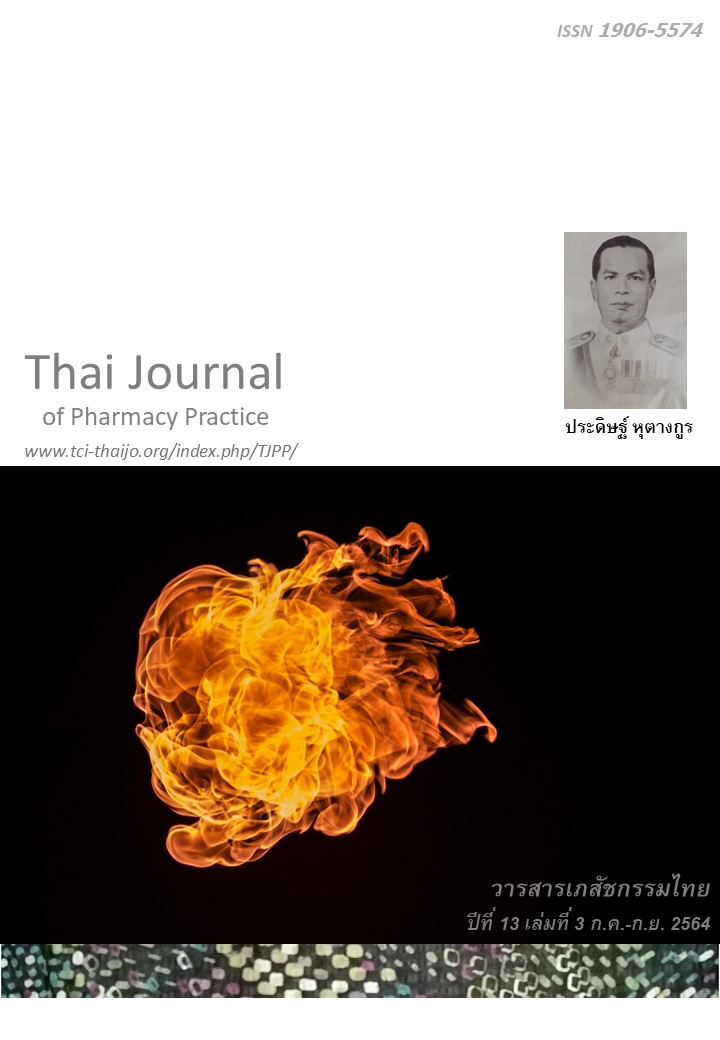ผลของการใช้แบบประเมินคุณภาพชีวิตด้านการใช้ยาต่อการสื่อสาร ระหว่างเภสัชกรกับผู้ป่วยและความพึงพอใจของผู้ป่วย
Main Article Content
บทคัดย่อ
วัตถุประสงค์: เพื่อเปรียบเทียบการสื่อสารเรื่องคุณภาพชีวิตด้านการใช้ยาในผู้ป่วยที่ได้รับการบริบาลทางเภสัชกรรมตามมาตรฐานปกติของโรงพยาบาล กับผู้ป่วยที่ได้รับการบริบาลทางเภสัชกรรมร่วมกับการใช้แบบสอบถาม Patient-Reported Outcome Measure of Pharmaceutical Therapy Quality of life (PROMPT-QoL) และเปรียบเทียบความพึงพอใจของผู้ป่วยทั้งสองกลุ่มต่อการใช้แบบสอบถาม PROMPT-QoL วิธีการ: การวิจัยเชิงทดลองแบบสุ่มที่มีกลุ่มควบคุมครั้งนี้ทำในผู้ป่วยนอกโรคเรื้อรัง 286 คน ที่เข้ารับการรักษาที่โรงพยาบาลสุราษฎร์ธานี ระหว่างเดือนตุลาคม 2562 ถึงเดือนพฤษภาคม 2563 การศึกษาแบ่งผู้ป่วยออกเป็น 2 กลุ่ม คือ กลุ่มควบคุมและกลุ่มศึกษา แบบสอบถาม PROMPT-QoL เป็นเครื่องมือที่ใช้ประเมินคุณภาพชีวิตด้านการใช้ยา และเป็นเครื่องมือช่วยในการบริบาลทางเภสัชกรรม มีจำนวน 43 ข้อ แบ่งเป็น 9 มิติ ผู้วิจัยเก็บข้อมูลครั้งที่ 1 โดยการบันทึกเสียงการสื่อสารเรื่องคุณภาพชีวิตด้านการใช้ยาระหว่างการให้การบริบาลทางเภสัชกรรม และนำมาประเมินเป็นคะแนนการสื่อสารฯ สำหรับความพึงพอใจต่อการใช้แบบสอบถาม PROMPT-QoL ประเมินโดยคำถาม 4 ข้อ ซึ่งผู้วิจัยเก็บข้อมูลนี้เมื่อผู้ป่วยกลับมาพบแพทย์ในนัดถัดไป ผลการวิจัย: ผู้ป่วยกลุ่มศึกษามีคะแนนการสื่อสารคุณภาพชีวิตด้านการใช้ยามากกว่ากลุ่มควบคุมอย่างมีนัยสำคัญทางสถิติ ทั้งคะแนนรวมและคะแนนในมิติที่ 2-9 (P < 0.001) กลุ่มศึกษามีความพึงพอใจด้านประโยชน์ในการดูแลการใช้ยามากกว่ากลุ่มควบคุมอย่างมีนัยสำคัญทางสถิติ (P = 0.024) สรุป: แบบสอบถาม PROMPT-QoL จัดเป็นแบบประเมินผลลัพธ์ที่รายงานโดยผู้ป่วยที่ดีในการกระตุ้นให้บุคลากรทางการแพทย์มีการสื่อสารทางด้านคุณภาพชีวิตด้านการใช้ยากับผู้ป่วยมากขึ้น และยังเพิ่มความพึงพอใจให้แก่ผู้ป่วยในการใช้เพื่อดูแลการใช้ยา
Article Details
ผลการวิจัยและความคิดเห็นที่ปรากฏในบทความถือเป็นความคิดเห็นและอยู่ในความรับผิดชอบของผู้นิพนธ์ มิใช่ความเห็นหรือความรับผิดชอบของกองบรรณาธิการ หรือคณะเภสัชศาสตร์ มหาวิทยาลัยสงขลานครินทร์ ทั้งนี้ไม่รวมความผิดพลาดอันเกิดจากการพิมพ์ บทความที่ได้รับการเผยแพร่โดยวารสารเภสัชกรรมไทยถือเป็นสิทธิ์ของวารสารฯ
เอกสารอ้างอิง
US Department of Health Human Services Food and Drug Administration. Guidance for industry: Patient-reported outcome measures: use in medical product development to support labeling claims [online]. 2009 [cited June 7, 2019]. Available from: www.fda. gov/regulatory-information/search-fda-guidance-doc uments/patient-reported-outcome-measures-use-me dical-product-development-support-labeling-claims.
Black N. Patient reported outcome measures could help transform healthcare. BMJ. 2013; 346: f167.
Dawson J, Doll H, Fitzpatrick R, Jenkinson C, Carr AJ. The routine use of patient reported outcome measures in healthcare settings. BMJ 2010; 340: c186.
Wu AW, Snyder C, Clancy CM, Steinwachs DM. Adding the patient perspective to comparative effectiveness research. Health Aff (Millwood) 2010; 29: 1863-71.
Ahmed S, Berzon RA, Revicki DA, Lenderking WR, Moinpour CM, Basch E, et al. the use of patient-reported outcomes (PRO) within comparative effect- tiveness research: implications for clinical practice and health care policy. Med Care 2012;50:1060-70.
Mayo NE. ISOQOL dictionary of quality of life and health outcomes measurement [online]. 2015 [cited Juy 4, 2019]. Available from: www.isoqol.org/diction ary/.
Reeve BB, Wyrwich KW, Wu AW, Velikova G, Terwee CB, Snyder CF, et al. ISOQOL recommends minimum standards for patient-reported outcome measures used in patient-centered outcomes and comparative effectiveness research. Qual Life Res 2013; 22: 1889-905.
Greenhalgh J, Long AF, Flynn R. The use of patient reported outcome measures in routine clinical practice: lack of impact or lack of theory? Soc Sci Med 2005; 60: 833-43.
Mohammed MA, Moles RJ, Chen TF. Impact of pharmaceutical care interventions on health-related quality-of-life outcomes:a systematic review and meta-analysis. Ann Pharmacother. 2016; 50: 862-81.
Westerlund T, Marklund B. Assessment of the clinical and economic outcomes of pharmacy interventions in drug‐related problems. J Clin Pharm Ther 2009; 34: 319-27.
Singhal PK, Raisch DW, GuPchup GV. The impact of pharmaceutical services in community and ambulatory care settings: evidence and recommend dations for future research. Ann Pharmacother 1999; 33: 1336-55.
Cheng Y, Raisch DW, Borrego ME, Gupchup GV. Economic, clinical, and humanistic outcomes (ECHOs) of pharmaceutical care services for minority patients: A literature review. Res Social Adm Pharm 2013; 9: 311-29.
Mohammed MA, Moles RJ, Chen TF. Pharmaceu tical care and health related quality of life outcomes over the past 25 years: Have we measured dimensions that really matter? Int J Clin Pharm. 2018; 40: 3-14.
Sakthong P, Suksanga P, Sakulbumrungsil R, Winit-Watjana W. Development of patient-reported outcomes measure of pharmaceutical therapy for quality of life (PROMPT-QoL): a novel instrument for medication management. Res Social Adm Pharm 2015; 11: 315-38.
Sakthong P, Chinthammit C, Sukarnjanaset P, Sonsa-ardjit N, Munpan W. Psychometric properties of the patient-reported outcomes measure of pharmaceutical therapy for quality of life (PROMPT-QoL). Value Health Reg Issues 2017; 12: 41-9.
Sangthonganotai T. Effect of phamaceutical care on drug therapy-related quality of life in outpatients [dissertation]. Bangkok: Chulalongkorn University; 2016.
Sakthong P, Sangthonganotai T. A randomized controlled trial of the impact of pharmacist-led patient-centered pharmaceutical care on patients’ medicine therapy-related quality of life. Res Social Adm Pharm 2018; 14: 332-9.
Yang L, Manhas D, Howard A, Olson R. Patient-reported outcome use in oncology: a systematic review of the impact on patient-clinician communi cation. Support Care Cancer 2018; 26: 41-60.
Velikova G, Booth L, Smith AB, Brown PM, Lynch P, Brown JM, et al. Measuring quality of life in routine oncology practice improves communication and patient well-being: A randomized controlled trial. J Clin Oncol 2004; 22: 714-24.
Detmar SB, Muller MJ, Schornagel JH, Wever LD, Aaronson NK. Health-related quality-of-life assess ments and patient-physician communication: a randomized controlled trial. JAMA 2002; 288: 3027-34.
Cohen J. Statistical power analysis for the behaviors science. 2 nd ed. New Jersey: Laurence Erlbaum Associates; 1988.
Cipolle RJ, Strand LM, Morley PC. Pharmaceutical care practice: The patient-centered approach to medication management services. New York: McGraw-Hill; 2012.
Cipolle RJ, Strand LM, Morley PC. Pharmaceutical care practice: The clinician's guide. 2nd ed. New York: McGraw-Hill; 2004.
Taenzer P, Bultz BD, Carlson LE, Speca M, DeGagne T, Olson K, et al. Impact of computerized quality of life screening on physician behaviour and patient satisfaction in lung cancer outpatients. Psychooncology 2000; 9: 203-13.
Santana M-J, Feeny D, Johnson JA, McAlister FA, Kim D, Weinkauf J, et al. Assessing the use of health-related quality of life measures in the routine clinical care of lung-transplant patients. Qual Life Res 2010; 19: 371-9.
Greenhalgh J, Gooding K, Gibbons E, Dalkin S, Wright J, Valderas J, et al. How do patient reported outcome measures (PROMs) support clinician-patient communication and patient care? A realist synthesis. J Patient Rep Outcomes 2018; 2: 42. doi: 10.1186/s41687-018-0061-6.
Boyer L, Lancon C, Baumstarck K, Parola N, Berbis J, Auquier P. Evaluating the impact of a quality of life assessment with feedback to clinicians in patients with schizophrenia: randomised controlled trial. BMJ 2013; 202: 447-53.
Lozano F, Lobos JM, March JR, Carrasco E, Barros MB, González-Porras JR. Self-administered versus interview-based questionnaires among patients with intermittent claudication: Do they give different results? A cross-sectional study. Sao Paulo Med J 2016; 134: 63-9.
Tsakos G, Bernabé E, O'Brien K, Sheiham A, de Oliveira C. Comparison of the self-administered and interviewer-administered modes of the child-OIDP. Health Qual Life Outcomes 2008; 6: 40.
Sakthong p, Sonsa-ardjit N, Sukarnjanaset P, Munpan W, Sangthonganotai T. Development and psychometrics of a short-form pharmaceutical care-specific measure for quality of life. Int J Clin Pharm 2018; 40: 642-9.


